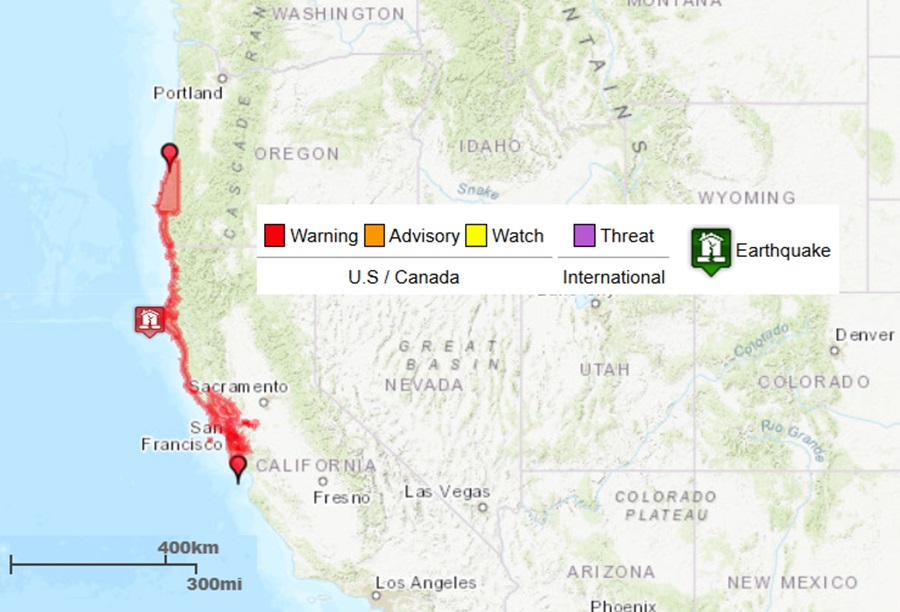
A strong earthquake struck just off the coast of northern California a short time ago, triggering a Tsunami Warning for a large portion of the U.S. West Coast.
According to the National Weather Service Tsunami Warning Center in Palmer, Alaska, a Tsunami Warning is in effect for California at the coast from Davenport, which is 10 miles northwest of Santa Cruz, to the Oregon/California Border including all of San Francisco Bay. The Tsunami Warning is also in effect for the the coast of Oregon from the Oregon/California state line to the Douglas/Lane Line which is 10 miles southwest of Florence.
“For other U.S. and Canadian Pacific coasts in North America, the level of tsunami danger is being evaluated. Further information will be provided in supplementary messages,” the Tsunami Warning Center said.
According to the Tsunami Warning Center, a magnitude 7.3 earthquake struck from a depth of 8 miles 45 miles southwest of Eureka, California which is also 215 miles northwest of San Francisco, California. The earthquake struck at 10:44 am local time.
The Tsunami Warning Center believes a tsunami could hit these areas at these times:
Fort Bragg, CA at 11:10 am
Crescent City, CA at 11:20 am
Port Orford, OR at 11:20 am
Brookings, OR at 11:25 am
Charleston, OR at 11:40 am
San Francisco, CA at 12:10 pm
The Tsunami Warning Center urges people in these areas to:
-Evacuate inland or to higher ground above and beyond designated tsunami hazard zones or move to an upper floor of a multi-story building depending on your situation.
-Move out of the water, off the beach, and away from harbors, marinas, breakwaters, bays and inlets.
-Be alert to and follow instructions from your local emergency officials because they may have more detailed or specific information for your location.
-If you feel a strong earthquake or extended ground rolling take immediate protective actions such as moving inland and/or uphill preferably by foot.
-Boat operators, where time and conditions permit, move your boat out to sea to a depth of at least 180 feet. If at sea avoid entering shallow water, harbors, marinas, bays, and inlets to avoid floating and submerged debris and strong currents.
-Do not go to the shore to observe the tsunami.
-Do not return to the coast until local emergency officials indicate it is safe to do so.
The Tsunami Warning center warns that if you are in a tsunami warning area:
-A tsunami with damaging waves and powerful currents is possible.
-Repeated coastal flooding is possible as waves arrive onshore, move inland, and drain back into the ocean.
-Strong and unusual waves, currents and inland flooding can drown or injure people and weaken or destroy structures on land and in water.
-Water filled with floating or submerged debris that can injure or kill people and weaken or destroy buildings and bridges is possible.
-Strong and unusual currents and waves in harbors, marinas, bays, and inlets may be especially destructive.
-Some impacts may continue for many hours to days after arrival of the first wave.
-The first wave may not be the largest so later waves may be larger.
-Each wave may last 5 to 45 minutes as a wave encroaches and recedes.
-Coasts facing all directions are threatened because the waves can wrap around islands and headlands and into bays.
-Strong shaking or rolling of the ground indicates an earthquake has occurred and a tsunami may be imminent.
-A rapidly receding or receded shoreline, unusual waves and sounds, and strong currents are signs of a tsunami.
-The tsunami may appear as water moving rapidly out to sea, a gentle rising tide like flood with no breaking wave, as a series of breaking waves, or a frothy wall of water.